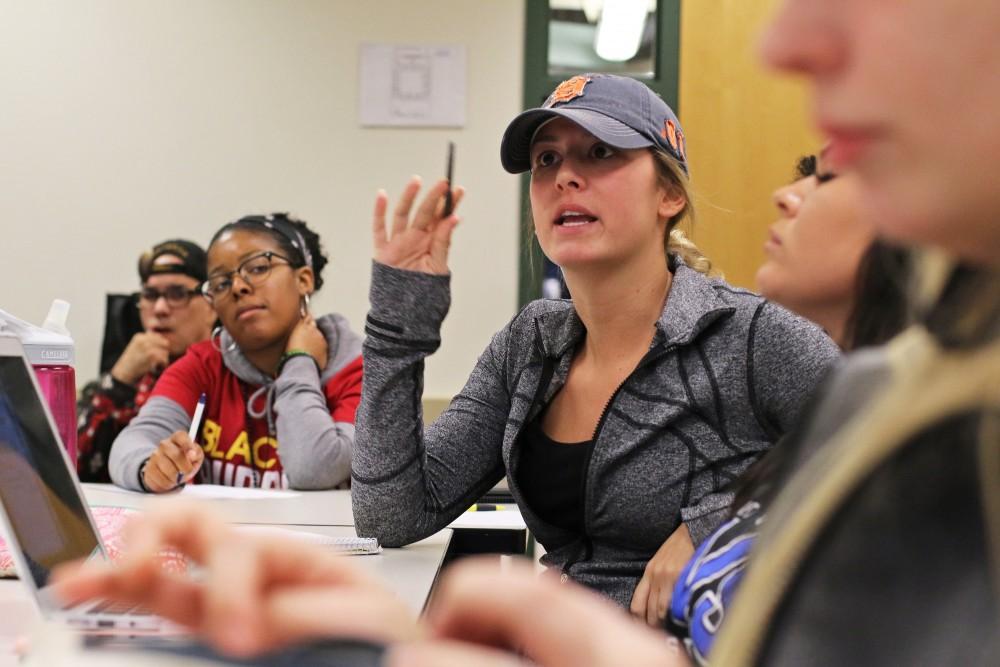Addressing ‘environmental injustices’

GVL/Meghan McBrady – Students speak to the group during the NAACP’s “Resistance” series talk on Monday, Mar. 20, 2017 in the Kirkhof Center.
Mar 23, 2017
Expanding on details of racism and privilege in modern society, the Grand Valley State University chapter of the National Association for the Advancement of Colored People (NAACP) conducted the second installment of its “Resistance” series Monday, March 20, in the Kirkhof Center.
A presentation and discussion forum, the “Environmental Injustices: The National Water Crisis” stressed environmental, racial and ethnic disparities within local, regional and national areas.
E’lexis Dudley, the public relations chair of GVSU’s NAACP chapter, said having the second part of the series examine environmental injustices within the U.S. capitalized how it was also a social justice issue which could lead to environmental racism.
“It is also appears that environmental justice concerns are more prominent among race/ethnicity lines rather than ventures of poverty,” she said.
Environmental justice is the fair treatment and involvement of all individuals—regardless of race, color or income—with respect to the development and enforcement of environmental laws and regulations.
With social justice being an environmental issue, as well, Dudley stressed how issues with air quality, exposure to toxic chemicals in flame retardants and disparities with drinking water are a few of several large environmental issues within the U.S.
The Flint water crisis, which began in 2014 and involved more than 100,000 residents being exposed to high levels of lead in the drinking water, was a central topic during the “Resistance” forum.
From videos and pictures of the individuals affected by the lead-poisoning to the brown water from the Flint River, the presentation also focused on the disproportionate exposure of ethnic minorities to the lead poisoning due to poverty and segregation relegating racial minorities to decrepit living environments.
“Water is a human right,” said Maria Hamming, vice treasurer of GVSU’s NAACP. “That’s been established by the U.N., and I don’t think anyone in this room would say that no one deserves clean, safe water.”
Beyond discussing the Flint water crisis and other water-based disparities, the event speakers also touched upon the Dakota Access Pipeline (DAPL) and the protests surrounding it.
From #TaketheMeeting to #ConsentNotConsulation, online and physical protests were held against the 1,172-mile DAPL which runs through North and South Dakota, Iowa and Illinois.
As a whole, the DAPL has the capacity to transport more than 500,000 barrels of oil in a day and would cross the primary water supply in the Standing Rock Indian Reservation.
Joe Cadreau, a member of the Native American Student Association (NASA) at GVSU who has worked with #NoDAPL protests and the Black Lives Matter movement, was the guest speaker for the DAPL talk.
He stressed to the room how the pipeline was originally supposed to go through Bismarck but was overturned and protested by the white residents of Bismarck.
Cadreau said the individuals protesting at the Standing Rock Indian Reservation weren’t there for “native lives” but were there to protect the 19 million people who drink out of the water supply surrounding the reservation.
“Those include native lives, but there aren’t 19 million natives in this country,” he said.
Stressing how the media have made the protests about “native water and native rights,” Cadreau said what is happening in North Dakota is about “all lives.”
Another thing about the pipeline, he said, is that people are becoming more aware and are learning about the legitimacy and the significance of Native Americans’ contribution to history and society.
Notably, he said, it is making individuals aware of protecting the death processes of the Native American community.
“Right now, our fight is about civil rights, and the sacred land part that I think a lot of people (don’t) understand, is that ‘oh, it’s just sacred land, I don’t see what the big deal is, it just happened two, three hundred years ago,’” Cadreau said. “Again, ignorant, it didn’t happen that long ago, but it happened less than a hundred years ago.
“Our sacred sites is just as important as Arlington or just as important where the pope is buried.”
Details for the third part of the resistance series will be announced at a later date.
For more information about the NAACP, visit www.naacp.org/.





















